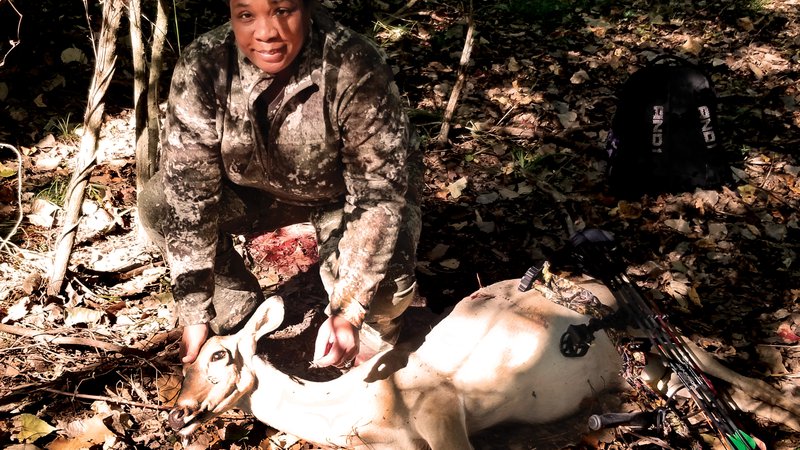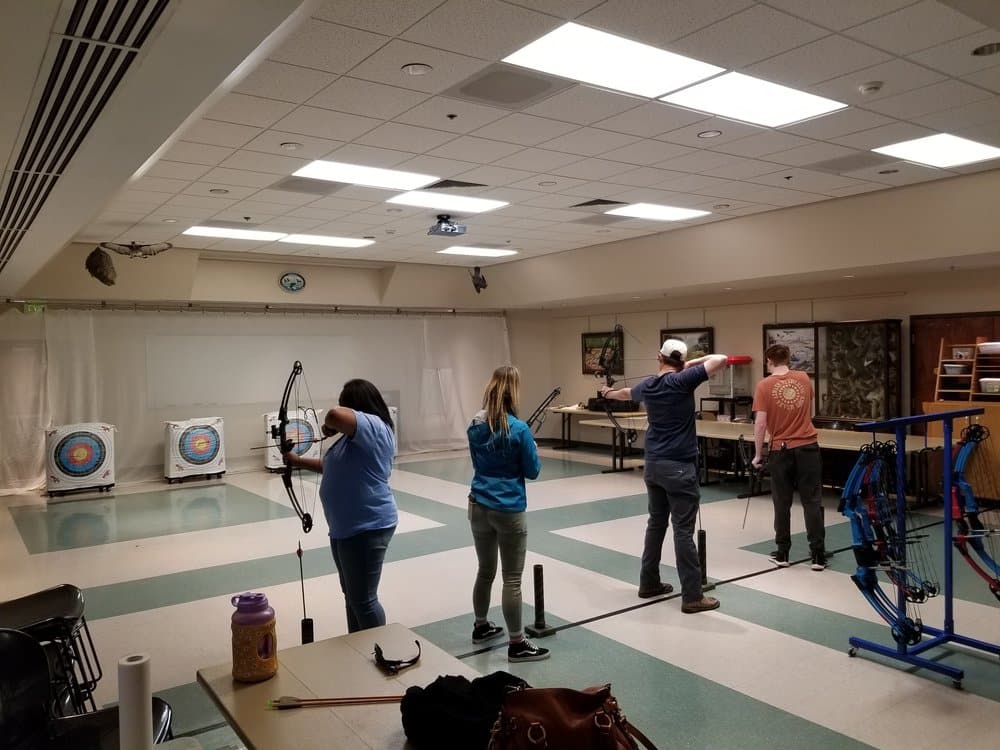First-time archer proves it’s never too late to start
ON 02-01-2023

Feb. 1, 2023
Randy Zellers
Assistant Chief of Communications
PINE BLUFF — Finding a place to start hunting if one doesn’t have family or friends who enjoy an outdoors lifestyle can be intimidating. Thanks to a new program through the Arkansas Game and Fish Commission’s Gov. Mike Huckabee Delta Rivers Nature Center, six “adult onset” hunters overcame that hurdle and joined the ranks of seasoned bowhunters last fall.
The AGFC teaches tens of thousands of school-aged children and teenagers each year how to shoot a bow and arrow. Bridging the gap from field archery to successful harvest of deer is a path that still requires many more steps with a teacher or mentor to guide the way. New mentored hunt programs are being developed through the AGFC’s Education Division to make this transition, and one has shown some real promise in recruiting hunters into one of the hardest types of deer hunting available — archery hunting.

A New Class
Last year marked the first year of the Beginning Bowhunting course at GMHDRNC. According to Trenton Powell, education program specialist for the center, the goal of the program is to focus much more on multiple sessions with a smaller audience than normal workshops. The hope is to develop people’s interests into fully fledged passions, guiding participants through the occasional setback that could derail their enthusiasm.
“We still do a lot of introduction classes to get people interested, but mentored hunting classes are a bit different,” Powell said. “We want to walk them through the progression of interest to learning, to trying it out. Ultimately, we hope they take up the sport and one day introduce someone else. It’s a long process, but we get to see the results and learn what works and what doesn’t.”
Powell took in applications to participate in the course last spring and selected six that had the most potential to attend all courses and complete the program.
“Many applicants had hunted before, just not bowhunted,” Powell said. “We had one who was starting from scratch.”
Although she loved the outdoors, Evette Browning had never hunted before. She didn’t have any family or friends that could serve as hunting mentors, especially for bowhunting, which she found interesting.

Jumping Hurdles
Starting from scratch may have helped Browning overcome a little-known hurdle for many first-time archers.
“She indicated she was right-handed, but her left eye was dominant,” Powell said. “Since we were starting from square one, I told her it would be best to work with the dominant eye, so she was introduced to archery with a left-handed bow.”
Browning and the rest of the class met with Powell 12 times, practicing first on small, field-archery style bows and indoor targets, then progressing to entry-level bowhunting bows.
“Hunting bows need to be set up for each individual user, so we walked them through the process of adjusting and sighting in their bows and matching up the proper arrow and broadhead combination for hunting,” Powell said.
Despite some issues with the string slapping her forearm, a common indicator of a flaw in a person’s setup or form, Browning persevered.
“String slap can scare off some people from continuing to shoot, but she learned to change her grip on the bow and overcame it,” Powell said. “She was determined to see the class through.”
Through the course of the class, participants also learned about deer biology and hunting techniques as well as hunter safety through the AGFC’s Hunter Education Program. They participated in 3D archery at the center, where they shot at lifelike targets shaped like deer and other game animals which score using the animal’s vital signs, rewarding shots that make the most lethal hits with the most points instead of using a round bull’s eye.

Into the Outdoors
By early October, they were ready to head to the woods, bow-in-hand, for the first time. Blinds overlooking feeding stations in nearby wooded areas had been prepared to increase each participant’s chance at seeing deer during their outing.
“We all met up, decided on our blind assignments, got our mentor and mentee teams lined out, and set out in the dark,” Powell said. “I was matched up with Evette, so when we got to the blind, I made sure she was comfortable and walked through how she could shift in the blind to shoot at different angles without hitting the blind if a shot presented itself. Then the wait was on.”
The morning was filled with updates from the other groups that saw deer and even took a few shots, but the action was very slow for Browning and Powell, with only one doe skirting around the edges of the area they were watching, out of range and at an angle that blocked any shot.
Squirrels and songbirds all made themselves known throughout the morning, but the deer were not as cooperative, at first.

It All Comes Together
“All the mentors decided to come out of the blinds at 9 a.m. to start tracking deer two of our other students had shot,” Powell said. “So I go to look at my phone and read 8:43 a.m. In my mind I’m preparing to pack it up to go help for the search.”
As if on cue, three does appeared, making their way to the feeder, just as Powell began to tell Browning it was time to call it a morning.
“She drew slowly, waited for the right shot, and released,” Powell said. “Then she got to experience another trial for bowhunters. The deer ducked the shot.”
Although the deer spooked, they didn’t go far. Powell told Browning to get another arrow ready in case they came back. Eventually, the deer made their way closer again. Evette waited for a perfect broadside shot, but the deer ducked the arrow again.
“At this point, I knew she was feeling discouraged, but the deer still hadn’t completely left, so I told her to load one last arrow,” Powell said. “It felt like it took forever for the last doe to come in; the deer would take some steps, stop, and look, trying to see what they heard. This time we were extra patient though we let this last deer come to the corn and eat for about 15 seconds, then we knew it was time for her final shot.”
Browning drew, calmed her nerves and made the shot.
“All of a sudden, we could hear a grunt, and the deer jumped in the air, but when she came to the ground she just began to walk away slowly,” Powell said.
The deer made its way up a small hill and laid down about 50 yards from the blind. Powell scanned the area where the shot had taken place and could see the arrow on the ground with blood on the vanes.
“She connected with this final shot and her deer was within view of us ready to be tagged and checked,” Powell said. “I wasn’t nervous for the whole encounter, but after we realized what had happened, neither of us could stop shaking.”
After the Hunt
Powell then walked Browning through the process of checking the deer and the two brought it back to camp to begin the final lesson of the hunt, how to prepare their deer for the processor.
“I’ve worked with a lot of people, teaching them about one or two aspects of the outdoors at a time, but seeing Evette and the rest of the class grow from completely new to harvesting and processing deer was the most rewarding experience I’ve had as a mentor. I can’t wait to do it again.”
The Beginning Bowhunting course will be offered again this year with the announcements and first classes beginning in April. Be on the lookout for it and other mentored hunting opportunities through the AGFC’s website, www.agfc.com and Facebook page.
Recent News

Arkansas Wildlife Weekly Fishing Report
Jul. 17, 2025
Subscribe to Our Weekly Newsletter E-mails
Don’t miss another issue. Sign up now to receive the AGFC Wildlife Weekly Newsletter in your mailbox every Wednesday afternoon (Waterfowl Reports are published weekly during waterfowl season and periodically outside the season). Fishing Reports arrive on Thursdays. Fill in the following fields and hit submit. Thanks, and welcome!

